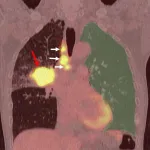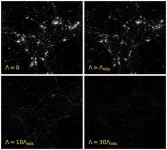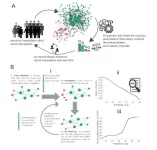(Press-News.org) The ketogenic “keto” diet and intermittent fasting have surged in popularity, embraced by everyone from weekend warriors to endurance athletes. These trends promise to harness the power of ketosis — a metabolic state where the body burns fat for energy instead of carbohydrates. Advocates tout its benefits, from weight loss to neuroprotection.
A collaborative research team is now tackling the unanswered questions surrounding ketosis.
Rather than adding to the growing, and often confusing, literature on the effects of ketogenic diets, the team — led by Jonathan Long, an associate professor of pathology at Stanford Medicine and institute scholar at Sarafan ChEM-H, and co-led by Yong Xu, professor of pediatrics at Baylor College of Medicine — are focused on the underlying chemistry of ketones themselves.
Their discovery — a previously unknown metabolic pathway and a family of “keto” metabolites — could rewrite our understanding of how ketosis influences metabolism, including in the brain.
“It turns out ketosis is not a monolithic state," said Long. "There’s a lot more complexity and nuance in how the body processes ketone molecules, and this could explain some of its more intriguing effects."
The research — published November 12, 2024 in Cell — was made possible by research grants from the Knight Initiative for Brain Resilience at Stanford’s Wu Tsai Neurosciences Institute, and the Stanford Wu Tsai Human Performance Alliance agility project, alongside other funding sources (see below for details).
A new chapter in metabolic science
When deprived of glucose — its primary energy source — the body shifts gears, breaking down fat to produce ketones as an alternative fuel. Central to this process is beta-hydroxybutyrate (BHB), the most abundant ketone body.
Until now, scientists believed ketosis followed two main biochemical pathways: ketogenesis, which produces BHB in the liver, and ketolysis (or ketone oxidation) which consumes BHB for energy throughout the body. These pathways were thought to tell the whole story.
Long and his team weren’t so sure. They decided to take another look at what ketones, particularly BHB, were doing in the body. Rather than diving into the already contentious literature on the ketogenic diet’s downstream effects — such as its potential benefits for cognition or metabolic health — they decided to take a step back.
“Let’s just step away from all the purported effects and focus on the chemistry of these metabolites,” Long explained. “Where do they come from? Where do they go?”
In a series of experiments on mice and humans, the researchers manipulated the availability of BHB to explore how it influences metabolism and energy balance. What they found was a previously unknown metabolic "shunt pathway," where enzymes attach BHB to amino acids, producing a family of compounds they dubbed BHB-amino acids.
"If pathways are like the highway system, shunts are the off-ramps," Long explained. "What we're saying is, this is not the main pathway that's directing traffic, but it gets you somewhere very interesting and unusual off the main road."
Ketones in the brain
The discovery of this ketone shunt suggests that ketones have additional, previously unrecognized roles in the body’s metabolic landscape. The critical question remained: Are they inert byproducts, or do they actively influence the body’s response to ketosis?
To answer these questions, Long and his collaborators zeroed in on the brain — a focus driven by a well-documented phenomenon: when people are in ketosis, their hunger often decreases.
“When I’m fasting or losing weight, I don’t feel as hungry,” said Long. “That’s a well-established aspect of ketosis, tied to the neurobiology of feeding and energy balance.”
Further, the team noticed that the metabolites they were studying chemically resembled another molecule recently discovered by Long and colleagues that is known to regulate hunger and appetite: Lac-Phe. Lac-Phe is produced in the body after sprint exercise, and functions to reduce appetite. This chemical resemblance guided their investigation, raising the question: Could these ketone metabolites play an active role in appetite suppression and weight regulation under ketosis conditions?
The researchers found that BHB-amino acids suppress feeding behaviors and promote weight loss, revealing a potent link between ketosis and energy regulation. “This third, shunt pathway turns out to be important for the regulation of appetite and ketosis-associated weight loss,” said Long.
Implications for Therapy and Research
By uncovering this previously unknown pathway, the researchers have created an opportunity to revisit longstanding questions about the mechanisms behind the ketogenic diet’s purported benefits.
Until now, “our basic understanding [of ketosis] was actually incomplete,” said Long. “Now, we can revisit all these phenomena through a new lens.”
For instance, while it’s well established that the ketogenic diet is uniquely effective in controlling seizures in children with drug-resistant epilepsy, it remains unclear whether other benefits, such as improved cognition or metabolic health, are real — and, if so, how they work. The identification of these metabolites offers a new framework for investigating these effects systematically.
What’s Next?
In fact, Long and his collaborators are already revisiting epilepsy with support from the Wu Tsai Neurosciences Institute.
Collaborating with Dr. Juliette Knowles, a clinical expert in epilepsy at Stanford, Long is investigating whether the newly identified shunt pathway and its metabolites play a role in seizure control. If so, this could open the door to novel treatments that replicate the benefits of ketosis without requiring a strict dietary regimen.
As the team continues to probe the fundamental biology of ketosis, their work could pave the way for a deeper understanding of its therapeutic potential — not just for epilepsy but for a range of metabolic and neurological conditions.
“Now that we have a better understanding of these pathways, we can ask much better questions about how and why these products might work — and what risks or limitations they might carry,” said Long.
Citation
This article refers to: “A β-hydroxybutyrate shunt pathway generates anti-obesity ketone metabolites.” Moya-Garzon, Maria Dolores et al. Cell. Published online November 12, 2024. https://doi.org/10.1016/j.cell.2024.10.032
Acknowledgments
This work was supported by the NIH (DK124265 and DK130541 to J.Z.L.; DK125260, DK111916, and P30DK116074 to K.J.S.; GM113854 to V.L.L.; HD112123 to M.W.; K99AR081618 to M.Z.; T32HL161270 to C.P.W.; R00AG058801 to E.L.G.; and T32GM136631 to A.S.-H.T.), the Phil & Penny Knight Initiative for Brain Resilience at the Wu Tsai Neurosciences Institute (research grant to J.Z.L.), the Ono Pharma Foundation (research grant to J.Z.L.), the Stanford Wu Tsai Human Performance Alliance (research grant to J.Z.L. and fellowship to X.L. and M.D.M.-G.), the Stanford Bio-X (SIGF graduate student fellowship to V.L.L.), the Jacob Churg Foundation (research grants to J.Z.L. and K.J.S.), the American Heart Association (fellowship #905674 to M.Z.), the Stanford School of Medicine (Dean’s postdoctoral fellowship to L.C.), the Independent Research Fund Denmark (2030-00007A to S.H.R.), the Lundbeck Foundation (R380-2021-1451 to S.H.R.), the American Heart Association (24POST1196199 to W.W.), the CIHR (PJ9-166217 and PJT-169116 to J.P.L.), the Ovarian Cancer Research Alliance (MIG-2023-2-1015 to A.D.-G.), the Fundación Alfonso Martin Escudero (fellowship to M.D.M.-G. and A.D.-G.), and USDA/CRIS (51000-064-01S to Y.X.).
Declaration of interests
A provisional patent application has been filed by Stanford University on BHB-amino acids for the treatment of cardiometabolic disease.
END
Unlocking the secrets of ketosis
2024-11-13
ELSE PRESS RELEASES FROM THIS DATE:
AI analysis of PET/CT images can predict side effects of immunotherapy in lung cancer
2024-11-13
Niigata, Japan – Dr. Watanabe and his teams from Niigata University have revealed that PET/CT image analysis using artificial intelligence (AI) can predict the occurrence of interstitial lung disease, known as a serious side effect of immunotherapy in lung cancer.
Immunotherapy has dramatically improved the treatment outcomes of primary lung cancer; however, it sometimes causes a serious side effect called interstitial lung disease. Interstitial lung disease is characterized by scarring (fibrosis) of the ...
Making an impact. Research studies a new side of helmet safety: faceguard failures
2024-11-13
There is a large window-lined laboratory in the back of one of Clemson University’s most storied buildings, Newman Hall, filled with machines that look like they were extracted straight from Dr. Jekyll’s lab. On one wall a contraption made of pullies and wires attached to the ceiling waits to drop objects and measure the impact; in the middle of the room, a giant metal base shakes a pallet of boxes in perpetuity; on the other side of the room sits what looks like a gigantic nut cracker big enough to squish a small car – but the most Medieval-looking area is the bay on the east side of the room full of machines designed to smack heads.
This is the Clemson Headgear ...
Specific long term condition combinations have major role in NHS ‘winter pressures’
2024-11-13
Specific combinations of long term conditions have a major role in the additional pressures the NHS faces every winter, because they are associated with significantly higher risks of hospital admissions and death, finds research published in the open access journal BMJ Medicine.
The risk of hospital admission was 11 times higher among those with the quartet of cancer, kidney disease, cardiovascular disease, and type 2 diabetes than it was among those without any of these long term conditions, the findings show.
And ...
Men often struggle with transition to fatherhood amid lack of targeted information and support
2024-11-13
Men often struggle with the transition to fatherhood amid a lack of information and emotional support targeted to their needs, suggests a review of the available qualitative evidence, published in the open access journal BMJ Open.
Greater focus is needed in clinical practice, antenatal services, and research on men’s unique experiences of the perinatal period, which encompasses pregnancy and the first 12 months after the birth, say the researchers.
Pregnancy and childbirth can be an anxious time for new parents, and the transition to fatherhood—defined ...
More green space linked to fewer preventable deaths in most deprived areas of UK
2024-11-13
The provision of just 1% more green space in the most deprived urban neighbourhoods in 3 out of the 4 UK nations may be linked to around 40% fewer preventable deaths in these areas, finds research published online in the Journal of Epidemiology & Community Health.
Green space is unequally distributed in England, Scotland, and Northern Ireland, with the lowest amounts in the most deprived areas, the findings show, prompting the researchers to suggest that green space investment might be an important public health strategy for tackling health inequalities.
Spending time ...
Immunotherapy drug pembrolizumab improves outcomes for patients with soft tissue sarcoma
2024-11-13
Addition of the immunotherapy drug pembrolizumab to standard of care for patients with advanced soft tissue sarcoma of the limb significantly improved disease-free survival, according to the results of the SU2C-SARC032 clinical trial led by researchers from the University of Pittsburgh, UPMC, Duke University and Princess Margaret Cancer Centre, University Health Network.
The findings, published today in The Lancet, establish pembrolizumab as a new option for patients with this disease.
“Soft tissue sarcoma is a rare and complex disease with over 50 different subtypes, which makes it hard to study in large clinical trials,” said lead author ...
A formula for life? New model calculates chances of intelligent beings in our Universe and beyond
2024-11-13
The chances of intelligent life emerging in our Universe – and in any hypothetical ones beyond it – can be estimated by a new theoretical model which has echoes of the famous Drake Equation.
This was the formula that American astronomer Dr Frank Drake came up with in the 1960s to calculate the number of detectable extraterrestrial civilisations in our Milky Way galaxy.
More than 60 years on, astrophysicists led by Durham University have produced a different model which instead focuses on the conditions created by the acceleration of the Universe's expansion and the amount ...
Could a genetic flaw be the key to stopping people craving sugary treats?
2024-11-13
The work provides novel genetic insights into dietary preferences and opens the possibility of targeting SI to selectively reduce sucrose intake at the population level.
The study was led by Dr. Peter Aldiss, now a group leader in the School of Medicine at the University of Nottingham, alongside Assistant Professor Mette K Andersen, at the Novo Nordisk Foundation Centre for Basic Metabolic Research in Copenhagen and Professor Mauro D’Amato at CIC bioGUNE in Spain and LUM University in Italy. It also involves scientists internationally from Copenhagen, Greenland, Italy and Spain as part of the ‘Sucrase-isomaltase working group’.
Dr Aldiss said: “Excess ...
Experts urge complex systems approach to assess A.I. risks
2024-11-13
[Vienna, November 13, 2024] — With artificial intelligence increasingly permeating every aspect of our lives, experts are becoming more and more concerned about its dangers. In some cases, the risks are pressing, in others they won't emerge until many months or even years from now. Scientists point out in The Royal Society’s journal that a coherent approach to understanding these threats is still elusive. They call for a complex systems perspective to better assess and mitigate these risks, particularly in light of long-term uncertainties and complex interactions between A.I. and society.
"Understanding the risks of A.I. requires recognizing the intricate interplay ...
Fossil fuel CO2 emissions increase again in 2024
2024-11-13
Global carbon emissions from fossil fuels have reached a record high in 2024, according to new research by the Global Carbon Project science team.
The 2024 Global Carbon Budget projects fossil carbon dioxide (CO 2) emissions of 37.4 billion tonnes, up 0.8% from 2023.
Despite the urgent need to cut emissions to slow climate change, the researchers say there is still “no sign” that the world has reached a peak in fossil CO2 emissions.
With projected emissions from land-use change (such as deforestation) of 4.2 billion tonnes, total CO2 emissions are projected to be 41.6 billion tonnes in 2024, up from 40.6 billion tonnes last year.
Over the last 10 years, fossil ...



